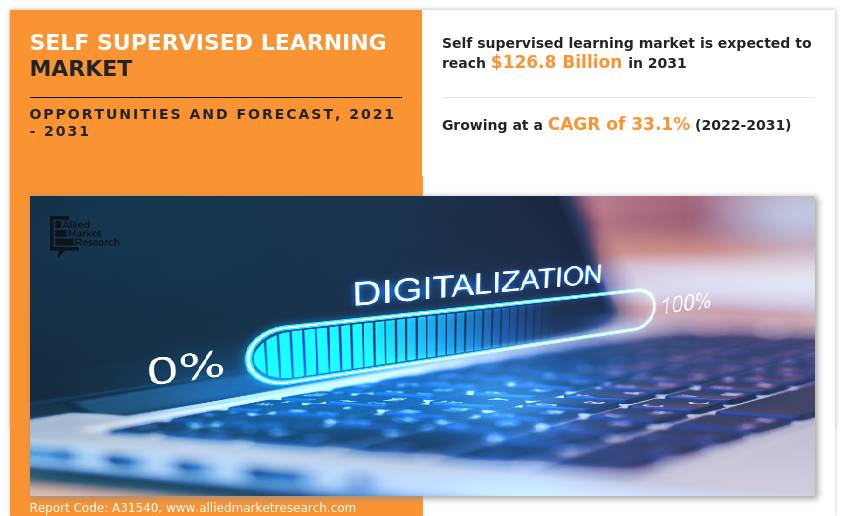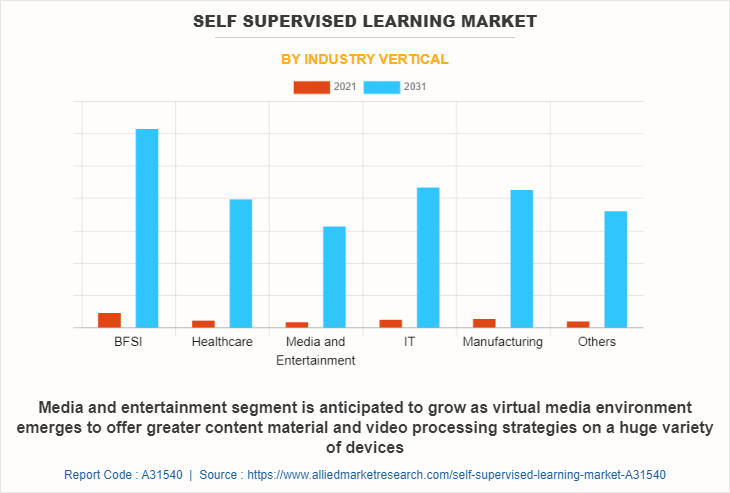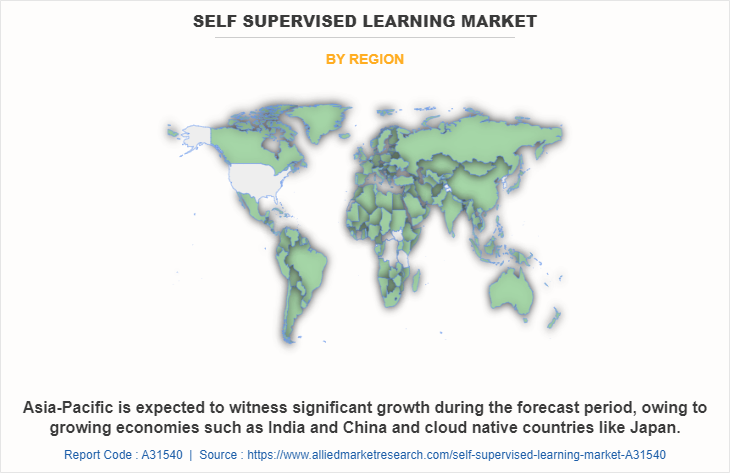Self Supervised Learning Market Research, 2031
The global self supervised learning market size was valued at $7.5 billion in 2021, and is projected to reach $126.8 billion by 2031, growing at a CAGR of 33.1% from 2022 to 2031.
Self-supervised learning (SSL) is an evolving machine learning technique poised to solve challenges posed by the over-dependence of labeled data. For many years, building intelligent systems using machine learning methods has been largely dependent on good quality labeled data. Consequently, cost of high-quality annotated data is a major bottleneck in the overall training process. As per IBM’s global AI adoption index 2022 report, 34% of respondents believed that a lack of AI skills restrain adoption of AI for businesses. Self-supervised learning is at a growing stage that requires skilled workforce for development. Hence, lack of skilled workforce is expected to restrain the self supervised learning market growth.

Furthermore, the key Self Supervised Learning Market Trends include increase automation in banking processes and increase use of internet and connected devices is boosting the growth of the global self supervised learning market. In addition, rise in demand for predictive analytics is positively impacts growth of the self supervised learning market. However, lack of skilled workforce for machine learning is hampering the self-supervised learning market growth. On the contrary, rapid changes in business model technology is expected to offer remunerative opportunities for expansion during the self supervised learning market forecast.
The self supervised learning market is segmented on the basis of technology, industry vertical, and region. By technology, the market is segmented into natural language processing, computer vision, and speech processing. The natural language processing segment is divided into rule-based NLP, statistical NLP, and hybrid NLP. The computer vision segmented is divided into quality assurance and inspection, positioning & guidance, measurement, identification, and predictive maintenance.The self supervised learning market is segmented into Technology and Industry Vertical.
By industry vertical, the Self Supervised Learning Industry is categorized into BFSI, healthcare, media & entertainment, IT, manufacturing, and others. The BFSI segment is further categorized into banking, financial services, and insurance. The segment is further categorized into life insurance and non-life insurance. Region wise, it is analyzed across North America, Europe, Asia-Pacific, and LAMEA.
The key players operating in the Self Supervised Learning Industry include Amazon Web Service (AWS), Alison, Alphabet, Apple, Inc., Baidu, Inc., Brain4ce Education Solutions Pvt. Ltd., DataCamp, Inc., Dataiku, Databricks, Datarobot, Inc., EDX LLC., International Business Machine (IBM), Microsoft Corporation, Meta, SAS Institute, The MathWorks, Inc., and Tesla. Furthermore, it highlights the strategies of the key players to improve the market share and sustain competition.
On the basis of industry vertical, the BFSI segment dominated the self supervised learning market share in 2021, and is expected to maintain its dominance in the upcoming years. Emergence of paperless storage, electronic banking, and virtualization across the BFSI industry fuels demand for safe, cost-effective, and energy-efficient platforms. In addition, massive volume of confidential data is generated that needs to be processed as well as stored in a secured environment. This has increased adoption of self-supervised learning techniques to develop the BFSI models. Moreover, self-supervised learning constructs a powerful framework for trading platforms. Since the introduction of e-trading platforms, the BFSI industry witnessed significant changes in traditional trading systems. Furthermore, increase in penetration mobile wallets, smart cards, and online banking has created a huge demand for better applications, which propels the self supervised learning market in this sector.

North America is anticipated to account for the largest share of the self supervised learning market analysis during the forecast period, owing to presence of a substantial industrial base in the U.S., government initiatives to promote innovation, and large purchasing power. Growth is primarily concentrated in the U.S. Companies that use big data software frequently use print management systems to cut costs, improve industry vertical, and boost worker productivity. However, Asia-Pacific is expected to witness significant growth during the forecast period, owing to growing economies such as India and China and cloud native countries like Japan.

Top Impacting Factors
Increase automation in banking processes
There was a surge in self-supervised technology adoption as artificial intelligence (AI) and machine learning (ML) technologies became more widely used in the BFSI industry. The AI-driven self-supervised learning empowers banks to keep up-to-date with the latest data, automate repetitive task, and internal processes, and improve productivity. In addition, it improves customer experience through predictive analytics and automate function where manual processes were previously required and personalize user-interface capabilities.
Moreover, artificial intelligence (AI) accelerates numerous operations across the BFSI industry and internal processes to achieve faster responses, produce quick projections, and provide rapid responsiveness. Furthermore, for improved security, artificial intelligence (AI) uses its unique capability of machine learning (ML) to recognize patterns, the ability to quickly identify and remediate possible risks with built-in self-recovery improves self-supervised learning security. The need for low-latency, real-time view and analytics on operational data.
Increase use of internet and connected devices
Setting up connection between various devices is implemented, owing to development of IoT and communication technologies in the BFSI industry. In addition, emergence of new technologies and digital revolution have altered how banks operate and interact with their clients. Moreover, growing demand for voice-based solutions that interface with self-supervised learning applications for providing better customer services, thus propels growth of the market.
Impact of COVID-19
The current estimation of 2031 is projected to be higher than pre-COVID-19 estimates. The COVID-19 outbreak has high impact on the growth of self supervised learning market, as increasing number of smartphone users, growing adoption of connected devices, and surging e-commerce sector provide lucrative opportunities for the growth of the self-supervised learning market. COVID has caused crises in social, economic, and energy areas and medical life worldwide throughout 2020. This crisis had many direct and indirect effects on all areas of society. In the meantime, the digital and artificial intelligence industry can be used as a professional assistant to manage and control the outbreak of the virus.
In post-pandemic circumstances, enterprises strived to minimize operational and running costs around all the business functions to recover the losses incurred in COVID times. The market for self-supervised learning observed unconstructive expansion, during the initial half of 2020. Owing to the limitations due to the global lockdown, media houses, a variety of offices, and the manufacturing divisions have observed a provisional shutting down. The demand for self-supervised learning is anticipated to gain steady traction over the coming years owing to the need for scalable and customized software.
Due to the COVID-19 pandemic, increasing health awareness among individuals has directed various doctors and health workers to deliver their services over applications. The increase in need for automation in customer service drives the growth of the self-supervised learning industry. In addition, rise in usage of machine learning by the younger generation, along with an improved user experience drives the demand for the market globally. This factor is anticipated to contribute to market growth.
Key Benefits for Stakeholders
- The report includes in-depth analysis of different segments and provides Self Supervised Learning Market Forecast between 2022 and 2031.
- The Porter’s five forces model illustrates potency of buyers & sellers, which is estimated to assist the market players to adopt effective strategies.
- Key market players are profiled to gain an understanding of the strategies adopted by them.
- This report provides a detailed analysis of the current trends and future estimations from 2022 to 2031, which helps identify the prevailing market opportunities.
Self Supervised Learning Market Report Highlights
| Aspects | Details |
| Market Size By 2031 | USD 126.8 billion |
| Growth Rate | CAGR of 33.1% |
| Forecast period | 2021 - 2031 |
| Report Pages | 334 |
| By Technology |
|
| By Industry Vertical |
|
| By Region |
|
| Key Market Players | Brain4ce Education Solutions Pvt. Ltd., IBM Corporation, DataRobot, Inc., Alphabet Inc. (Google LLC), Alison, DataCamp, Inc., Baidu, Inc., Databricks, Microsoft Corporation, Apple, Inc., Tesla, edX LLC., Meta, Dataiku, SAS Institute, Amazon Web Series, The MathWorks, Inc. |
Analyst Review
In accordance with insights by CXOs of leading companies, one of the current trends in the self-supervised learning market that is gaining traction in both developed and emerging economies is the growing need for mobile-based applications. Moreover, machine learning techniques require training datasets to make predictions. Data scientists need to label observations in training datasets manually or with data labelling tools to enable AI to understand input data and make accurate predictions about new data. In cases where the training dataset is too large, manually labelling training data can be quite costly and time-consuming. Self-supervised learning eliminates necessity of data labelling. It enables computers to label, categorize, and analyse data themselves.
In the digital era where artificial intelligence and internet of things have taken over the world, there seems to be a comparatively less growth rate of the self-supervised learning market than digital marketing. Through various studies, it has been observed that self-supervised learning market is expanding as a result of the quickening pace of digital transformation in all parts of the world. It automatically generates labels without human intervention and enables machines to come up with a solution without any interference. Facebook VP and chief AI scientist Yann LeCun shares that self-supervised learning is a step toward how human intelligence works. Consequently, growth in popularity of the internet propels growth of the market share for self-supervised learning.
Furthermore, increase automation in banking processes and increase use of internet and connected devices is boosting the growth of the global self-supervised learning market. In addition, rise in demand for predictive analytics is positively impacts growth of the self-supervised learning market.
North America is anticipated to account for the largest share of the self-supervised learning market during the forecast period, owing to presence of a substantial industrial base in the U.S., government initiatives to promote innovation, and large purchasing power.
The global self-supervised learning market was valued at $7,456.99 million in 2021, and is projected to reach $126,780.56 million by 2031, registering a CAGR of 33.1% from 2021 to 2031.
The key players operating in the market include Amazon Web Service (AWS), Alison, Alphabet, Apple, Inc., Baidu, Inc., Brain4ce Education Solutions Pvt. Ltd., DataCamp, Inc., Dataiku, Databricks, Datarobot, Inc., EDX LLC., International Business Machine (IBM), Microsoft Corporation, Meta, SAS Institute, The MathWorks, Inc., and Tesla. Furthermore, it highlights the strategies of the key players to improve the market share and sustain competition.
Loading Table Of Content...
Loading Research Methodology...



